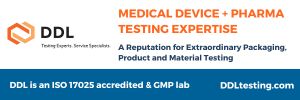Analytical Testing
RedShiftBio Launches New Protein Characterization Instrument System
RedShift™ BioAnalytics, Inc. (RedShiftBio™) unveiled the AQS3™pro, a new protein characterization platform with powerful, integrated bioanalytics software that delivers automated, high sensitivity spectroscopic analysis for the development, formulation and manufacture of biotherapeutics.
WuXi STA to Build New R&D Center
STA Pharmaceutical Co., Ltd., a subsidiary of WuXi AppTec (WuXi STA), recently announced it has signed an investment agreement with the government of Shanghai, Jinshan District to build a new R&D center.
Thermo Fisher Scientific Unveils Gibco ExpiSf System
Thermo Fisher Scientific recently announced its Gibco ExpiSf system, the first-ever chemically defined insect protein expression system.
Ritter Pharmaceuticals Selects Medpace as its CRO for Pivotal Phase 3 Trial
Ritter Pharmaceuticals, Inc. recently announced it has signed an agreement with the clinical research organization (CRO) Medpace to conduct the first of two pivotal Phase 3 clinical trials for RP-G28 in patients with lactose intolerance (LI).
NEOMED-LABS Renews Strategic Agreement With GSK
Laval headquartered NEOMED-LABS, a global leader in the clinical immunology field, recently announced a 3-year extension of their strategic agreement with GSK, the world’s largest vaccine manufacturer.
EXECUTIVE INTERVIEW - Singota Solutions: Keeping Up With Trends & Technology as a CDMO
Brent Lieffers, Senior Director of Operations, discusses the need for keeping up with trends and technology as an innovative CDMO.
PREFILLED SYRINGES - Prefilled Syringe Automated Inspection & End-Product Testing
Gregory A. Sacha, PhD, introduces the common equipment available for automated inspection and discusses inspection testing methods for prefilled syringes.
ORALLY INHALED PRODUCTS - Optimizing the Application of In Vitro Test Methods for the Demonstration of Bioequivalence in Orally Inhaled Products
Mark Copley, MEng, and Anna Sipitanou, MSc, examine the testing strategies demonstrating the BE of OIPs, their relevance, and the submission approaches outlined by the FDA and EMA.
EXECUTIVE INTERVIEW - MilliporeSigma: Accelerating the Development & Manufacture of Gene Therapies, Immunotherapies & Viral Vaccines
Dave Backer, Head of Virus & Gene Therapy Strategic Initiatives at MilliporeSigma, talks about his company’s expanding GMP capacity to speed development and manufacture of gene therapies, immunotherapies, and viral vaccines.
EPR SPECTROSCOPY - Bringing EPR to a Wider World: Biological ROS & RNS Detection
Kalina Ranguelova, PhD, demonstrates how the latest digital and microwave technologies in benchtop EPR instrumentation is giving researchers new insight into ROS and free radicals that may shape the future development of more effective treatments of disease.
SCALE-UP & MANUFACTURING - Smart Formulation, Processing & Engineering Solutions to Solve Drug Product Scale-Up & Manufacturing Challenges With Minimum to No Regulatory Impact
Anil Kane, PhD, MBA, explains how many smart formulation process or engineering solutions can be applied to overcome challenges of the material properties to successfully manufacture quality products at the development and commercial scale with minimum to no clinical or regulatory impact.
SPECIAL FEATURE - Analytical Testing - Contractors Take on the Challenge of Complex Molecules
Contributor Cindy H. Dubin highlights some of the analytical testing services that leading contractors offer aimed at the increasing complexities of today’s pharmaceutical pipelines.
NEXT-GENERATION SEQUENCING - Emerging Clinical Applications & Projections to 2022
Laurie L. Sullivan and John Bergin, MS, MBA, say the growth curve for clinical applications of NGS is approaching an upward trajectory as existing applications gain traction and new ones begin to establish a foothold.
CENTRALIZED BIOMETRICS - The Backbone of a Global Clinical Data Strategy
Paul Fardy details the steps needed to implement a successful global clinical data strategy and how to approach developing a centralized process that results in transparency, traceability, accuracy, and collaboration.
ONCOLOGY DIAGNOSTICS - Advancements Paving the Way for More Tailored Drugs
Divyaa Ravishankar, MS, says pharmaceutical companies have been subjected to a wide variety of external forces compelling them to get innovative about development of new platforms, liaise with new partners, leverage big data toward precision and predictive diagnosis, and identify new markers.
MDI CHARACTERIZATION - Closing the Gap Between In Vitro Test Data & the In-Use Performance for Metered Dose Inhalers
David A. Lewis, PhD, presents experimental data that shows how certain modifications to the Pharmacopoeial test methods used for MDIs may result in data that is more indicative of real-life performance, providing insight that can be used to enhance drug delivery characteristics.
ASSAY VALIDATION - Biomarker Assay Validations – A Time for Change?
John L. Allinson, FIBMS, believes despite the increased use of biomarkers, it appears that many researchers are still continuing to use the FDA guidance document for validation even though it only critically addresses the validation of assays to support PK evaluation, and also has a limited scope described within the document in terms of studies where it should be used.
SAMPLE PREPARATION MARKETS - Automation & Application Trends Drive Growth in Sample Preparation Markets
Christi Bird indicates sample preparation remains a critical task in many research and testing workflows across biopharmaceutical, basic research, clinical, and industrial applications. While the market lacks the hype and excitement of NGS, CRISPR/Cas9, or the microRNA and epigenetics boom several years ago, the sample preparation market will always be a slow and steady gainer on an already large market size.
AAV VECTOR MANUFACTURING - Challenges & Opportunities in the Manufacturing of AAV Vectors Used in the Delivery of Gene Therapy Treatments
Daniel C. Smith, PhD, indicates there remains a clear need for improved process productivities, and the need to develop manufacturing processes that can be applied to a wide number of AAV-based viral vector therapeutic candidates.
BIOMARKERS - FDA’s Design Control Requirements for Biomarkers in Drug Development
Kaiser J. Aziz, PhD, says the availability of validated biomarker-drug companion products will enable the molecular diagnostics and pharmaceutical industries to develop and rely on new genomic biomarkers in order to elucidate disease pathways, stratify patient populations, and monitor safe and effective use of these products.




















